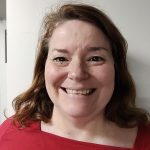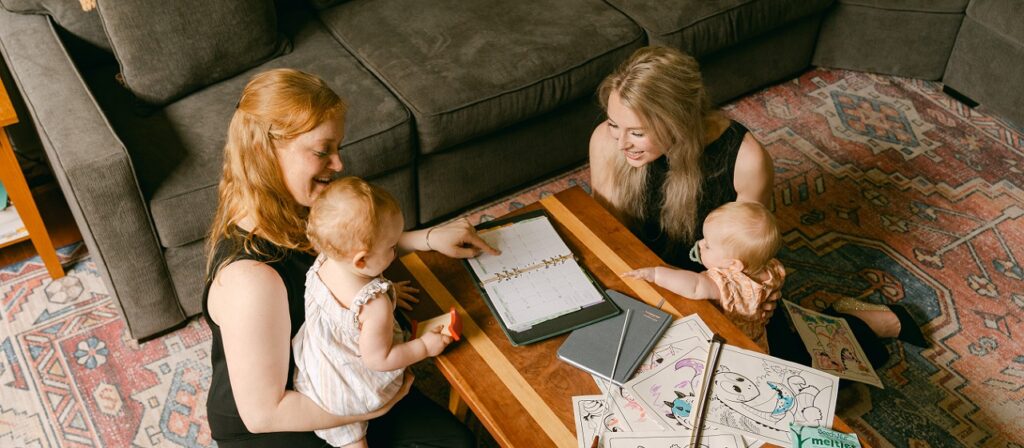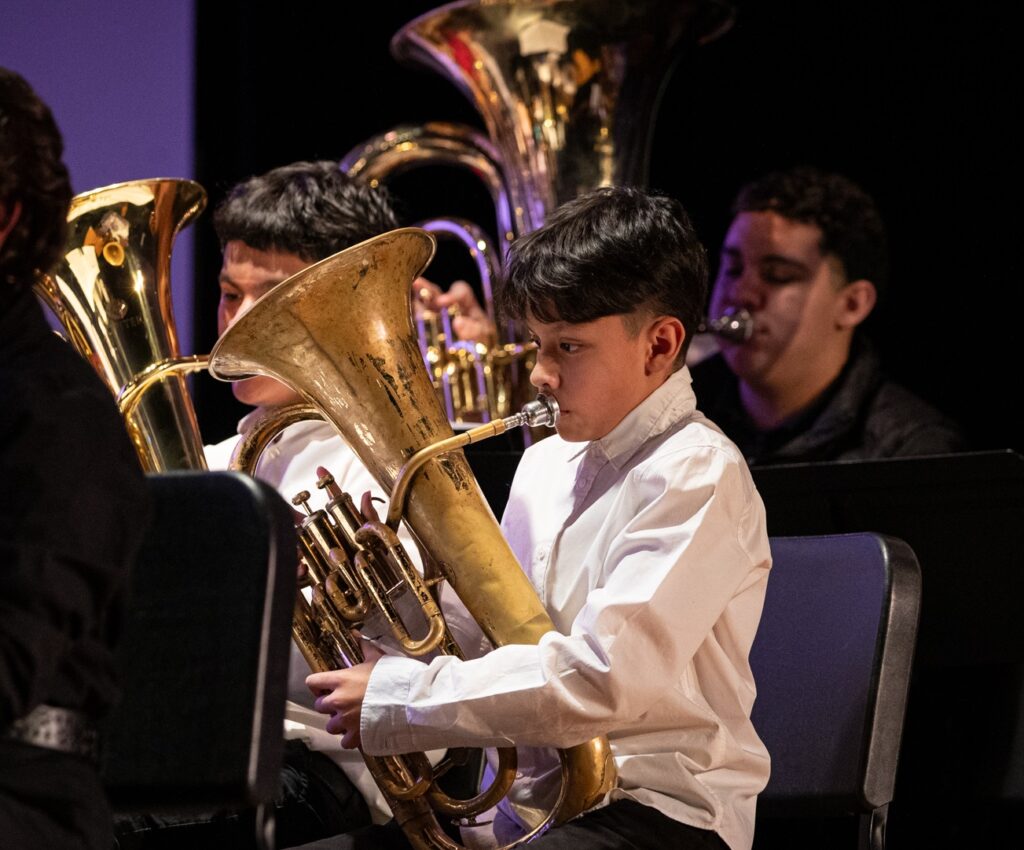Tagged Under:
An Orchestra for Students with Disabilities
A Virginia educator creatively tailors and individualizes music education for students with significant and severe disabilities.
Annie Ray was named the 2024 GRAMMY Music Educator partially for creating the Crescendo Orchestra program, which creatively personalizes music education to the specific needs of each student with physical and intellectual disabilities. “Crescendo has been such a long learning process, and I’ll never stop learning from the students and the experts in the field,” says Ray, the Orchestra Director and Performing Arts Department Chair at Annandale High School.
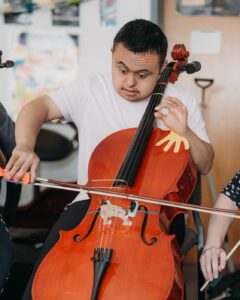
A Once-In-A-Lifetime Opportunity
Ray will never forget the twin brothers she taught in elementary school several years ago: Both had significant intellectual disabilities, and she felt frustrated with herself because they were in her mainstream strings class that met once a week, and the boys were struggling to learn how to play.
“I felt like I was absolutely failing them,” Ray recalls. “Until one day I kept them after class and worked with them one on one and realized that they knew everything I was teaching but were just processing and showing me their learning in different ways.”
Then the COVID-19 pandemic struck in 2020, and students were grounded at home. When kids gradually started to return to school, students with significant disabilities were some of the first ones to arrive back at campus. Ray found that she had missed working with students with disabilities. Together with paraprofessionals, general music teachers and caregivers, she put together a music education program called Crescendo that was designed specifically for students with disabilities.

Using a lot of trial and error and improvisation, Ray and special education professionals wrote a curriculum that enables students to learn to play the violin, viola, cello or bass through meeting each one of them where they are at. With the slowdown of the pandemic, Ray was able to put a lot of time into creating imaginative lessons.
“It was this entire period of freedom,” Ray says. “There was nobody looking over my shoulder to see what I was doing. I had this entire school year to create.”
Now in its fifth formal year, Crescendo has 15 students, who work with Ray and instructional assistants in 80-minute classes just like their general education peers. The students have a variety of physical and intellectual disabilities, and each receives a tailored approach that plays on their strengths and minimizes their limitations. Ray rewrites the program and pushes the boundaries every year, so it meets every student where they are at. The Crescendo Orchestra students play in all four annual concerts alongside their peers in general education, so they get exposure and recognition, and some even go on to join the main school orchestra.

Adaptions and Learning
In Crescendo Orchestra, many students have physical or sensory disabilities that impact how they interact with traditional instruments. This has given Ray the opportunity to explore creative adaptations, customizing instruments and approaches to support each student’s unique strengths and needs. For example, for students who experience sound sensitivity, Ray may assign lower-pitched instruments that sit farther from the ears or provide noise-reducing headphones to create a more accessible environment.
“The things I’ve had the most fun are unique approaches like super-gluing a cello to an old marching drum harness for a student who has lower muscle tone. It worked!” Ray says. “That’s the cool thing about Crescendo — there are no rules! We just get creative in figuring out what playing violin or viola or cello looks like,” Ray says.
Kids, both in general education and the Crescendo program, get nervous about learning to play an instrument at first. They don’t want to sound bad — but, that’s simply a part of learning. Everyone sounds bad at first, Ray explains, and hands-on, in-person instruction and practice is required to learn to play an instrument and to improve.
“Music is so personal,” says Ray, who was recognized as a 2025 Yamaha “40 Under 40” music educator, says. “To improve, you have to accept that you’re going to sound really bad at first. All kids want to do is be on TikTok and hide away. In every other subject, they can do that. In orchestra, they can’t do that. Music is one of the last sanctuaries in the education system where we don’t have devices in the way. If students are playing, they can’t be on their devices.”

Music educators, Ray says, have a responsibility to meet students where they are — especially in a program like Crescendo, where students have special needs and need an individualized approach. And learning, in all its challenges and messiness, is where music is made; the recitals and concerts are just the end product.
“Everything I do is about the process, not the product,” Ray says. “Music is not the universal language, but the act of making music is. It is one of the most unifying and humanizing experiences.”
One student, Kevin, was not happy to be in the orchestra at first because it was far outside his usual routine. But when he drew the bow across the string for the first time, Kevin’s eyes welled with tears as he felt the vibrations. After graduating, Kevin returned to co-teach Crescendo Orchestra alongside his godfather Scott Engdahl, a tireless volunteer for the group.
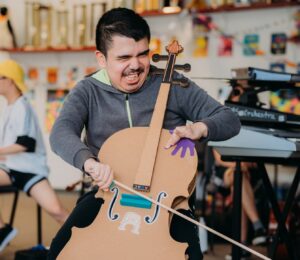
Giving Students a Voice
Many parents have shared with Ray about how much Crescendo Orchestra has benefitted their children. She remembers one boy named Dean, who had severe intellectual and physical disabilities. In her Tedx Talk, “The Sound of Success,” Ray explained that Dean is a mobility device user and uses augmentative communication devices and gestural communication. Through Crescendo, he was able to engage his gross- and fine-motor skills in the creation of sound.
“Music can come from anyone, anywhere — you just have to be willing to give them a voice,” Ray says in her Tedx Talk.
Together with her paraprofessional team, Ray helped Dean access music education terminology through a word wall of sticky notes with different symbols and terms. Dean was able to identify “100% of the time if a note was high or low, fast or slow and various musical notations.”
After diving through general music curriculum and scaffolding holding instruments with practice instruments, it was time to move on to traditional instruments. Rather than focusing on what Dean couldn’t do, the team leaned into what was possible. Together, they brainstormed creative ways to adapt the instrument so that it would meet Dean where he was both physically and musically. One solution was surprisingly simple and deeply effective: Duct tape a violin to a sturdy stand, which allowed him to play without needing to hold it. This small act of ingenuity opened a new world of sound and expression for Dean and became a symbol of how flexible thinking and teamwork can unlock opportunities for every student to participate fully and joyfully in music-making.
“It’s about the musicking (the act of making music coined by Christopher Small); it’s about the ‘in-betweens,’” Ray says in her Tedx Talk.
Dean’s family gave Ray thank-you flowers and a note she hung up on her bathroom mirror that said: “Thank you for believing in Dean.”
“I’m just grateful for that family for allowing me the joy of spending time with him,” Ray says.
“We have to redefine what success is,” she says. “The majority of our students are not going to become the next Yo-Yo Ma, but it does not mean their music-making is any less equal to a professional musician. It’s fundamentally about connecting with others.”

All-Around Benefits
Even when a student with a disability isn’t in Crescendo Orchestra specifically — such as one student on the autism spectrum who participates in a different orchestra class — the benefits of music education are still profound.
“His mom shared that since he joined orchestra, his grades have improved across the board,” Ray says. “The skills he’s building in music, like focus, pattern recognition and perseverance, are transferring to his other classes.”
Beyond academics, this student’s participation has supported growth in social-emotional and executive functioning skills. Through ensemble work, he’s practicing collaboration, managing transitions and developing confidence in a group setting. “Music is where he feels successful,” Ray adds. “And that sense of success is spilling over into every part of his school day.”
Crescendo students perform at every concert alongside their general education peers and experience a real sense of self-confidence
“You can see it on the kids’ faces when they hear cheers at a concert — their first time getting to be on stage and celebrated,” Ray says. “Parents are telling me: ‘Thank you, thank you, thank you!’ And I say: ‘No, thank you! Everything that your child is has fundamentally changed who I am as a teacher.’”
Ray gets these reminders of how she impacts young lives every day, and she feels so lucky. “I get to just be this lovely observer,” she says.
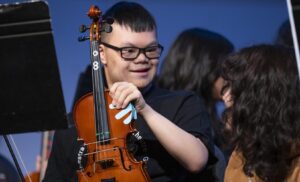
Collaborative Community
Ray emphasizes that Crescendo involves the efforts and hard work of many adults and children, and not just her. She puts it this way: “The GRAMMY isn’t mine.”
“I just want to stress that Crescendo is the culmination of so many people’s work and knowledge coming together,” Ray says. “I am not the only music educator out there doing this work. My hope is that we can all come together and work together to amplify this. This should be the norm instead of the exception.”
She is especially appreciative of the Annandale Special Education team as well as her instructional assistants Anna-Maria Awad, Nick Jacky, Anai Moreno and Viann Tran for their collaboration and partnership.
Ray encourages other music teachers to start Crescendo-like programs. Many resources and organizations exist that could help like United Sound, and Ray is available, too.
“If anyone ever wants help, just contact me and I will give you everything I have!” she says.
In addition to Crescendo, Ray also spearheaded the Parent Orchestra, implemented an arts-based, anti-absenteeism program and started Motherhood and Music Education, which provides resources and support for music teachers on extended leave.









